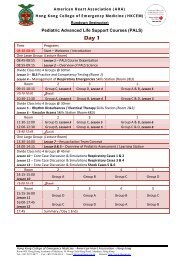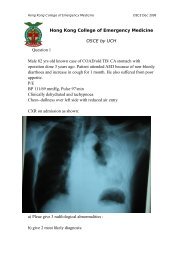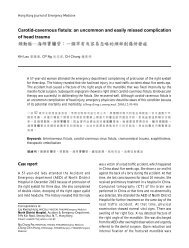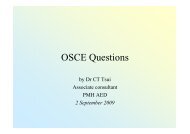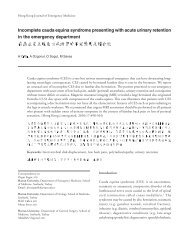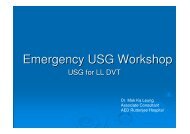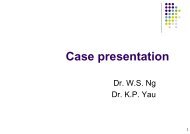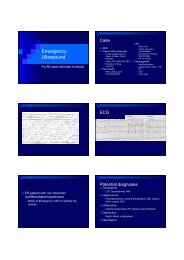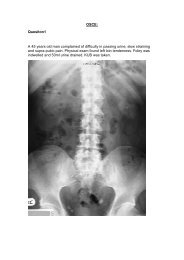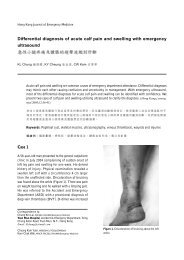OSCE - Hong Kong College of Emergency Medicine
OSCE - Hong Kong College of Emergency Medicine
OSCE - Hong Kong College of Emergency Medicine
Create successful ePaper yourself
Turn your PDF publications into a flip-book with our unique Google optimized e-Paper software.
Joint Clinical Meeting<br />
and Didactic Lectures<br />
<strong>OSCE</strong><br />
By<br />
UCH AED<br />
2-1-20082008
Case 1<br />
What device is showed on the CXR?
Case 1<br />
a)What device is showed on the CXR? (1 Mark)<br />
b)What kind <strong>of</strong> disease may need that device?<br />
(1 Mark)<br />
c)What do you need to do to perform an ECG for this<br />
unconscious patient? (1 Mark)<br />
d)If the patient needs defibrillation, what precautions<br />
will be needed? (2 Marks)
Case 2<br />
67 F consulted an alternative medicine<br />
practitioner ( 氣 功 師 ) for general malaise and<br />
low body weight<br />
She was advised to take a cooked grass carp<br />
gallbladder ( 鯇 魚 膽 )<br />
She developed nausea and epigastric pain 2 hrs<br />
after ingestion
Photos <strong>of</strong> the grass carp and the<br />
grass carp gallbladder
Changes <strong>of</strong> alanine aminotransferase (ALT),<br />
alkaline phosphatase (ALP), bilirubin and<br />
creatinine <strong>of</strong> the patient<br />
IU/L<br />
8000<br />
7000<br />
6000<br />
5000<br />
4000<br />
3000<br />
Day 5<br />
900<br />
800<br />
700<br />
600<br />
500<br />
400<br />
300<br />
umol/L<br />
ALT (IU/L)<br />
ALP (IU/L)<br />
Bilirubin (umol/L)<br />
Creatinine (umol/L)<br />
2000<br />
200<br />
1000<br />
100<br />
0<br />
0<br />
0 5 10 15 20 25 30<br />
days
Case 2<br />
a)What is the toxin involved ?(0.5 Mark)<br />
b)What are the typical features <strong>of</strong> poisoning ?<br />
(3 Marks)<br />
c)Please suggest a specific treatment. (0.5 Mark)<br />
d)Is chronic renal failure a typical feature ?<br />
(1 Mark)
Case 3<br />
A 45 years old lady presented with syncope<br />
while on the way to work with loss <strong>of</strong><br />
consciousness and some seizure activity noted<br />
lasting for 1 min.<br />
On arrival to AED, patient already regained<br />
consciousness. An ECG was performed and<br />
shown as follow.
Case 3 ECG
Case 3<br />
a)What is the diagnosis ? (1 Mark)<br />
b)Name 3 possible underlying causes. (3 Marks)<br />
c)What type <strong>of</strong> cardiac arrhythmia is the patient<br />
prone to ? (1 Mark)
Case 4<br />
A 58-year old gentleman, back seat passenger <strong>of</strong> a<br />
private car, was brought to AED after the vehicle was<br />
hit head on by a bus.<br />
On arrival, his vital signs were:<br />
GCS 15/15. BP 142/78 mmHg, Pulse 68 bpm, , RR<br />
16/min, SpO2 100% on 2 L oxygen supplement.<br />
On examination, chest air entry was equal and good.<br />
There was tenderness and guarding over the abdomen.
Case 4 Patient’s s clinical photo<br />
©Charles<br />
Gomersall August 2007
Case 4<br />
a)Name the sign on this photo. (1 Mark)<br />
b)Name 4 possible injuries in this gentleman?<br />
(2 Marks)<br />
FAST performed in the AED was negative.<br />
X-rays cervical spine, chest and pelvis were all<br />
normal.<br />
c)What further investigation(s) ) would you like to<br />
order? (1 Mark)
Case 4<br />
His BP dropped to 96/45 mmHg and pulse to<br />
105 bpm even with IV fluid bolus while waiting<br />
for further investigations.<br />
d)What is your further action?(1 Mark)
Case 5<br />
A 48 years old chronic hypnotic user presented<br />
with drowsiness after taking about 100 tablets <strong>of</strong><br />
“ 白 瓜 子 ” 2 hours ago.<br />
Her initial vital signs were as follow:<br />
GCS 9/15 (E3V1M5), pupils 2mm ERL, BP<br />
88/59 pulse 67/min, Sp O2 88% in room air.<br />
She was noticed to have shortness <strong>of</strong> breath and<br />
central cyanosis.
Case 5<br />
a)Name the (two) drugs that known as “ 白 瓜 子 ”<br />
in <strong>Hong</strong> <strong>Kong</strong> (1 Mark).<br />
Which is the more commonly encountered one<br />
nowadays? (0.5 Mark)<br />
b)Supposed the taken drug is the commonly<br />
encountered 白 瓜 子 nowadays. Is it a<br />
benzodiazepine? (0.5 Mark)<br />
What is its mechanism <strong>of</strong> action? (1 Mark)
Case 5<br />
<br />
c)Give 2 possible causes <strong>of</strong> the central cyanosis<br />
in this case. (Clinical diagnosis before ABG<br />
available) (1 Mark)<br />
<br />
Arterial blood gas was taken:<br />
pH 7.31, CO2 2.7kPa (20.3mmHg),<br />
O2 26.5kPa (198.8mmHg), HCO3 9.7mmol/L,<br />
BE -14.1
Blood sample is shown in the<br />
diagram below.<br />
Patient’s blood<br />
Normal Control
Case 5<br />
<br />
d)What is the likely diagnosis? (0.5 Mark)<br />
<br />
The patient has a haemoglobin concentration<br />
<strong>of</strong> 9.6g/dL. Clinically she is dyspnoeic.<br />
<br />
e)What is the antidote that can be used?<br />
(0.5 Mark)
Case 6<br />
<br />
<br />
<br />
<br />
<br />
<br />
<br />
M/72 had known diabetes mellitus, hypertension and ischemic<br />
heart disease.<br />
He was recently admitted because <strong>of</strong> chest infection two weeks<br />
ago.<br />
This episode, he presented with chest pain.<br />
Vital signs:<br />
<br />
BP 110/70, pulse 110/min., Temperature 36.7, SpO2 98% on room air<br />
ECG showed sinus tachycardia with normal ST segment<br />
CXR showed widen mediastinum<br />
CT thorax was done after a bedside Echo
Case 6 CXR
Case 6 CT Thorax
Case 6
Case 6<br />
a)Name the most alarming CT finding? (1 Mark)<br />
b)What is the diagnosis? (1 Mark)<br />
c)What is the typical characteristic <strong>of</strong> the pain as<br />
described by patient? (0.5 Mark)<br />
d)What is the pathognomonic physical sign? (0.5 Mark)<br />
e)Name 2 classical ECG findings <strong>of</strong> the diagnosis in<br />
acute stage? (1 Mark)<br />
f)Name 2 most likely underlying causes in this patient?<br />
(1 Mark)
Thank You




